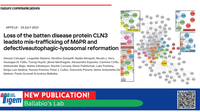Authors: Alessia Calcagni’, Leopoldo Staiano, Nicolina Zampelli, Nadia Minopoli, Niculin J. Herz, Giuseppe Di Tullio, Tuong Huynh, Jlenia Monfregola, Alessandra Esposito, Carmine Cirillo, Aleksandar Bajic, Mahla Zahabiyon, Rachel Curnock, Elena Polishchuk, Luke Parkitny, Diego Luis Medina, Nunzia Pastore, Peter J. Cullen, Giancarlo Parenti, Maria Antonietta De Matteis, Paolo Grumati & Andrea Ballabio
Year: 2023
Sources: Nature Communications
Abstract:
Batten disease, one of the most devastating types of neurodegenerativelysosomal storage disorders, is caused by mutations in CLN3. Here, we showthat CLN3 is a vesicular trafficking hub connecting the Golgi and lysosomecompartments. Proteomic analysis reveals that CLN3 interacts with severalendo-lysosomal trafficking proteins, including the cation-independent man-nose 6 phosphate receptor (CI-M6PR), which coordinates the targeting oflysosomal enzymes to lysosomes. CLN3 depletion results in mis-trafficking ofCI-M6PR, mis-sorting of lysosomal enzymes, and defective autophagic lyso-somal reformation. Conversely, CLN3 overexpression promotes the formationof multiple lysosomal tubules, which are autophagy and CI-M6PR-dependent,generating newly formed proto-lysosomes. Together, our findings reveal thatCLN3 functions as a link between the M6P-dependent trafficking of lysosomalenzymes and lysosomal reformation pathway, explaining the global impair-ment of lysosomal function in Batten disease.
Category: journals

